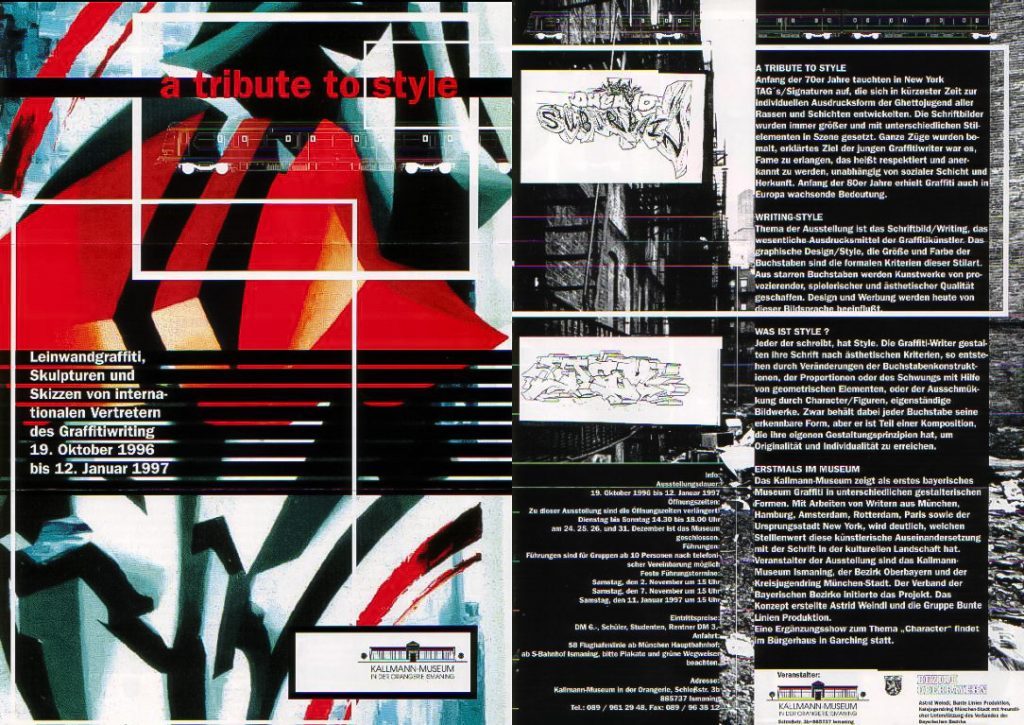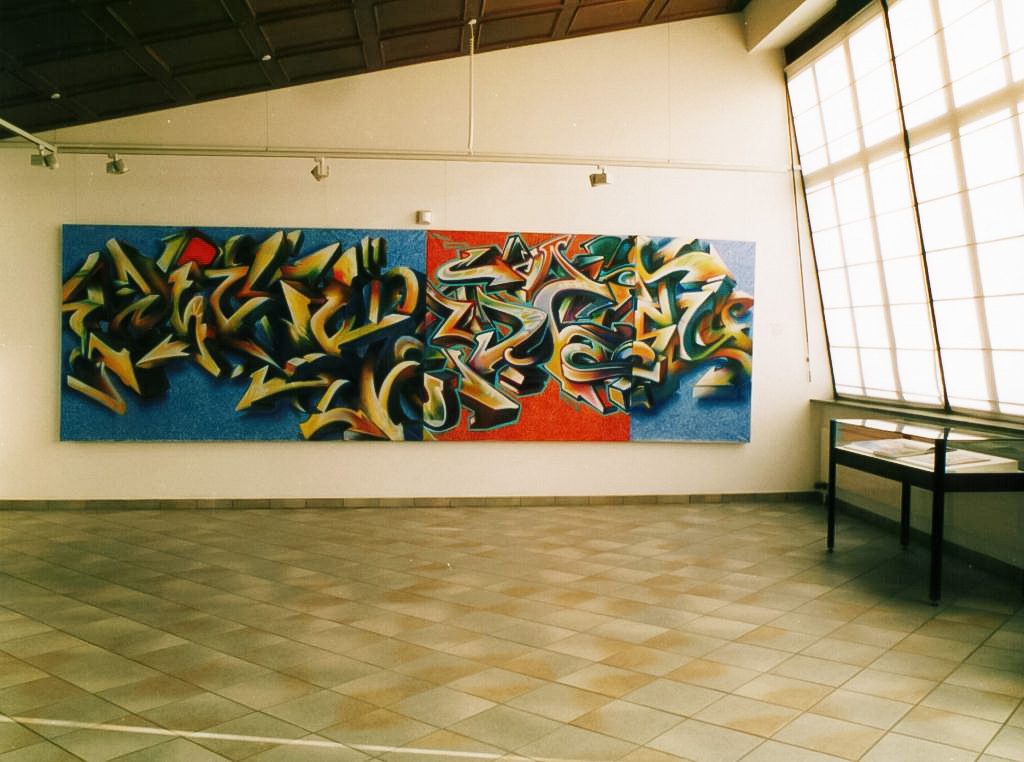28 years later: 2nd edition of “Theory of Style – The Liberation of the Alphabet” (from 1996)
By CHEECH H, SCUM aka CEMNOZ and TECHNO 169 aka STONE aka Don Karl 2nd edition published by Hitzerot, Berlin 2024
During a research fellowship in 2017, I had the original 1996 edition of Theorie des Style – Die Befreiung des Alphabets in my hands. I visited Don Karl in his office at From here to fame publishing in Berlin. He only had one copy of Theorie des Style – Die Befreiung des Alphabets left, unfortunately it had been out of print for a long time. It was the best theoretical book on style writing that I had found in Berlin at the time. In 2018 I had the chance to curate the photo exhibition SORRY! in Berlin, together with Mark Straeck. In 2019, this exhibition was also shown in Brussels called as Berlin:Writing Graffiti and the exhibition catalog of the same name was published by Hitzerot. For this exhibition, I asked Don Karl and Cemnoz if I could use some passages from their book for the show They agreed and we printed some passages in a booklet format for visitors to leaf through in the show. At the opening in Berlin, we talked to the makers of Hitzerot about a new edition of this important book. Almost every year when I met Don Karl or Sascha Blasche from Hitzerot, I kept asking what was going on with it and was really happy when I heard they were working on it. Exactly 6 years later, it has actually happened. The 2nd edition is now available again in German and also in English for the 1st time.
So instead of writing a review, I decided to ask the co-author Don Karl a few questions for this article. I can only recommend all readers to read this book.


Interview with co-author Don Karl aka Stone aka Techno169
In the added introduction in the separate small booklet of the new edition Theory of Style – The Liberation of the Alphabet, you tell us how this book came about. Can you briefly explain here for readers who are not yet familiar with the book how this project came about in 1996?
Work on the book began back in 1989, when Cemnoz and I were very active on trains and walls in Munich. Our style developed a lot during that time. Cheech and I wrote letters to each other because he was out of town. Three thick file folders, a large part of which was concrete work on the theory of style.

In 1991, the three of us had the Graffiti Futurism exhibition, then we went our separate ways. In 1996, we all wrote the book together with great concentration. It was published for the exhibition A Tribute to Style at the Kallmann Museum near Munich.

„A Tribute to Style“ Kallmann Museum, 1996
©Don Karl



How old were you three makers CHEECH H, SCUM aka CEMNOZ and you in 1996?
All about 27-28 years old.
Have you been to New York before?
Yes of course, Cemnoz and I were in New York for the first time in 1986, we were lucky enough to experience the completely bombed subways.
Have you done any research there? Where else?
I did research there too, but for my first book Die Züge gehören uns, which was published by Heyne Verlag in 1987. The research on Theory of Style mainly took place in books and libraries. We read piles of books and discovered references to style writing everywhere. Kandinsky, Kant, Popper, Camus, Wittgenstein, Stanislaw Lem, Harald Fritsch, Stephen Hawking, Alan Turing. We found them all relevant. And of course books on the history of writing and the texts by Rammellzee and Phase2.
Did you interview writers in advance?
No, what for? That wasn’t the point at all, we put everything we knew and had found out ourselves into it.
You write in the introduction to the new edition that only a small essence of CHEECH H’s and your thoughts made it into the book. Which ones did make it?
We could have written many more pages on each of the topics and chapters we discussed and made many more observations. Our original fantasy back in 1989 was that we wanted to define style so precisely and comprehensively that an AI could use it to create styles.
Are there any other thoughts/writings by the two of you from back then that don’t appear here that could be published?
All three of us wrote a lot of texts, some of which we published, some not. My early 3D-style experiments flowed into a secret text, the Codex Technozoikum, in 1992; only very select personalities such as Torch received it. In 1993, Cheech and I wrote Fantastiturbula, a science fiction novel. It was written by hand by candlelight in a fishing village in Ghana due to the lack of a typewriter. And Cemnoz wrote about the brotherhood of styles, his life and his performance art.
If you could rewrite “Theory of Style – The Liberation of the Alphabet” and expand it, what would you add?
Nothing, it’s a timeless document in this form, which is why we published it again as it is. Of course, that doesn’t mean that nothing has happened since then and that there wouldn’t be a lot of new things to write about style.
In your introduction you mention the further development of the style, including the anti-style, the breaks and further developments with classic style writing since the mid-90s. What happened stylistically in the mid-90s (where, who)?
In the mid-90s, there was total digital networking. Then it was finally over with individual islands where styles led an independent life uninfluenced for a while. There were now an absolutely unmanageable number of writers all over the world. The bar was raised higher and higher in all aspects, especially in trainwriting. In the mid-90s, the point was reached where all art styles and techniques were absorbed by graffiti writing and made available for style. Nevertheless, to this day there have always been individual writers who have shaped an entire style that you suddenly saw everywhere, often used by writers who were completely unaware of it. Back then, we still saw a very linear development and were able to explain it with the theory of style. Today, style is a fractal with so many facets that even the biggest nerds find it difficult to trace the branches.
Could these further developments after the mid-1990s also be the subject of a similar theoretical publication? Do you see this as a particular field of interest for research?
There were certainly many people who thought about it. Many writers have written or spoken about style. We have also seen a few approaches in book form. The history from European Wild Style to Antistyle to Abstract Graffiti to the many free, wonderful style constructs that we see today. I would love to read that.
Which chapter do you personally find most important in “Theory of Style – The Liberation of the Alphabet”?
They are all totally important. I hope that none of the three of us will say anything else.
Which sketch in the book do you personally like best?
I don’t have a favorite. It’s a special selection of very special writers from different eras: Phase 2 early 1970s, Crime Time Kings early 1980s, Cheech’s and my 3D experiments from 1989/1990 and then the many contributions from 1996.










Pressrelease
Theory of Style / The Liberation of the Alphabet
Theorie des Style was a book which originally got published to the occasion of the A Tribute to Style exhibition near Munich in 1996. 13 years after graffiti writing travelled from New York to the world Munich was one of the metropolises of style writing. CHEECH H and TECHNO169 (STONE), both writers from the first generation, did exchange letters and thoughts on style already for years at that point. Together with SCUM (CEMNOZ) they published the first in-depth analysis of letter forms, style writing, and its origins.
Today style writing still is an important genre within graffiti, practiced by thousands of writers worldwide. Although techniques may have developed further, designing the 26 letters of the alphabet following the New York traditions still is the foundation to most writers’ pieces. The analytic content did not lose any of its importance so making it available again some 30 years later seems absolutely legit. The authentic 90s layout by SMAL (Mirko Borsche) as well as the content was left almost untouched, apart from minor corrections. To keep the original aesthetics also the translation was not just added, but made as a separated book so the content is now available in English for the very first time. We are especially happy to republish this long sold out classic as a high quality hardcover including an additional retrospective insert written by TECHNO169 (STONE).
Featuring works from: BOMBER, DAZE, CHEECH H, PHASE2, DELTA, TECHNO169 (STONE), BANDO, DAIM, SHOE, SMAL, ATOME, BATES, SCUM (CEMNOZ), AMOK, PUPPET, SKENA, PAZE, CALEB, DARCO, and NEON.
96 pages, 21 x 14 cm, hardcover Language: German or English (2 different books) Release date: May 2024 (1996) ISBN: 978-3-9820295-6-6
Publisher: Hitzerot
Available for 30€ at www.hitzerot.com






Leave a Reply